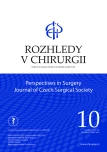-
Medical journals
- Career
Analysis of postoperative complications after open scar hernia hernioplasty – a retrospective analysis of a patient cohort
Authors: M. Drienko 1; Z. Šubrt 1,2; A. Whitley 1; M. Neterdová 1; R. Gürlich 1,2
Authors‘ workplace: Chirurgická klinika 3. lékařské fakulty Univerzity Karlovy a Fakultní nemocnice Královské Vinohrady, Praha 1; 3. lékařská fakulta Univerzity Karlovy v Praze 2
Published in: Rozhl. Chir., 2022, roč. 101, č. 10, s. 488-493.
Category: Original articles
doi: https://doi.org/10.33699/PIS.2022.101.10.488–493Overview
Introduction: The aim of this study was to analyse complications associated with inicisional hernia repair surgery and to assess individual risk factors for surgical site infections occurring at the Department of Surgery of the University Hospital Kralovske Vinohrady in 2015.
Methods: We analysed 138 patients with a focus on risk factors that potentially increase the risk of postoperative infectious complications such as mesh implantation, smoking, diabetes mellitus, ischemic heart disease, malignancies, immunosuppressive therapy and urgency of the procedure.
Results: Based on multivariate logistic regression analysis, acute surgery proved to be a risk factor for infection, and in the ad hoc Fisher test, the ratio was 2.73. Diabetes mellitus as a risk factor reached the limit of significance (p=0.071). No other variables were associated with an increased risk of surgical site infections.
Conclusion: Acute surgery was assessed as a significant risk factor for postoperative wound infection. On the contrary, mesh repair was not associated with an increased risk of infection.
Keywords:
Hernia – complication – infection – hernioplasty
Sources
1. Zeman M, Krška Z, et al. Speciální chirurgie, 3. vyd. Praha, Galén 2014 : 157–164.
2. Reynolds D, Davenport D, Roth JS. Predictors of poor outcomes in functionally dependent patients undergoing ventral hernia repair. Surg Endosc. 2013;27(4):1099–1104. doi: 10.1007/ s00464-012-2587-7.
3. Škach J, Šlamborová M, Blechar V, et al. Současný pohled na protézy v herniologii (kýlní síťky) – klasifikace, indikace, výhody a nevýhody jednotlivých materiálů, komplikace. Rozhledy v chirurgii 2019;98 : 85–99.
4. Passot G, Villeneuve L, Sabbagh C, et al. Definition of giant ventral hernias: Development of standardization through a practice survey. International Journal of Surgery 2016;136–140. doi: 10.1016/j.ijsu. 2016.01.097.
5. Dindo D, Demartines N, Clavien PA. Classification of surgical complications, a new proposal with evaluation in a cohort of 6336 patients and results of a survey. Ann Surg. 2004;240(2):205–213, doi: 10.1097/01.sla. 0000133083.54934.ae.
6. Khorgami Z, Hui BY, Mushtaq N, et al. Predictors of mortality after elective ventral hernia repair: an analysis of national inpatient sample. Hernia 2019;23 : 979–985. doi: 10.1007/s10029-018-1841-x.
7. Kroese LF, Kleinrensink GJ, Lange JF, et al. External validation of the European Hernia Society classification for postoperative complications after incisional hernia repair. Journal of the American College of Surgeons 2017;226(3):1072–7515(17) doi: 10.1016/j.jamcollsurg.2017.11.018.
8. Ferguson DH, Smith CG, Olufajo OA, et al. Risk factors associated with adverse outcomes after ventral hernia repair with component separation. JSR 2020;258 : 299–306, doi: 10.1016/j. jss.2020.08.063.
9. Nobaek S, Rogmark P, Petersson U, et al. Negative pressure wound therapy for treatment of mesh infection after abdominal surgery: Long-term results and patient-reported outcome. Scandinavian Journal of Surgery 2017;106(4):285–293. doi:10.1177/1457496917690966.
10. Berrevoet F, Vanlander A, Sainz-Barriga M, et al. Infected large pore meshes may be salvaged by topical negative pressure therapy. Hernia 2013;17(1):67–73. doi: 10.1007/s10029-012-0969-3.
11. Henriksen NA, Montgomery A, Kaufmann NR, et al. Guidelines for treatment of umbilical and epigastric hernias from the European Hernia Society and American Hernia Society. British Journal of Surgery 2020;107(3):171–190 doi:10.1002/ bjs.11489.
12. Berríos-Torres SI, Umscheid CA, Bratzler DW, et al. Centers for disease control and prevention guideline for the prevention of surgical site infection. JAMA Surg. 2017;152(8):784–791. doi:10.1001/ jamasurg.2017.0904.
Labels
Surgery Orthopaedics Trauma surgery
Article was published inPerspectives in Surgery

2022 Issue 10-
All articles in this issue
- Doktorský studijní program v biomedicíně − obor Experimentální chirurgie
- Prognostic factors of renal cell carcinoma
- Cholangiocelulární karcinom z pohledu patologa
- Analysis of postoperative complications after open scar hernia hernioplasty – a retrospective analysis of a patient cohort
- The role of intraoperative frozen section of central neck lymph nodes in the management of patients preoperatively diagnosed with low- risk differentiated cancer
- Acute appendicitis in supraumbilical hernia
- Defenzivní medicína
- Inflammatory cloacogenic polyp in an adolescent – case report and review of the literature
- Diaphragmatic hernia after radiofrequency ablation of liver tumor − case report and literature review
- Perspectives in Surgery
- Journal archive
- Current issue
- Online only
- About the journal
Most read in this issue- Cholangiocelulární karcinom z pohledu patologa
- Acute appendicitis in supraumbilical hernia
- Prognostic factors of renal cell carcinoma
- Inflammatory cloacogenic polyp in an adolescent – case report and review of the literature
Login#ADS_BOTTOM_SCRIPTS#Forgotten passwordEnter the email address that you registered with. We will send you instructions on how to set a new password.
- Career

